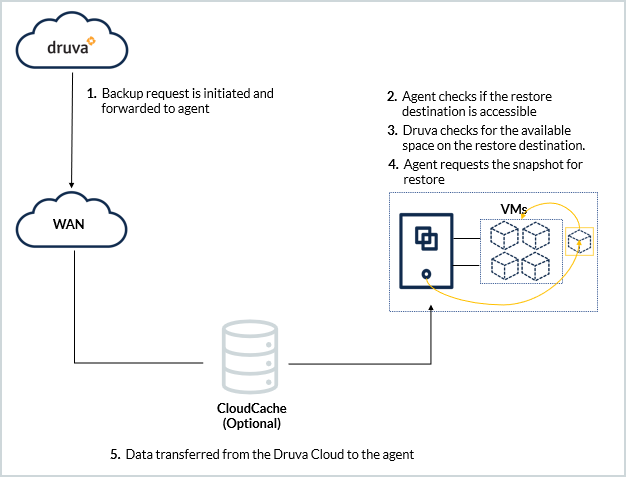About Hyper-V virtual machine restore
 Business
Business  Enterprise
Enterprise  Elite
Elite
After you configure your virtual machines for backup, Druva creates recovery points and stores them in the cloud. If a virtual machine runs into an issue, Druva lets you restore your virtual machine to its last created recovery point. Druva provides the following restore options:
- Full virtual machine restore
- Virtual disk restore
Druva supports the following restore workflows:
- Restore virtual machine to original location
- Restore virtual machine to alternate location
Restore workflow

| Step | Operations |
|---|---|
|
Step 1 |
Administrator initiates virtual machine restore. Druva forwards the restore request to the Hyper-V server agent. |
|
Step 2 |
Druva checks if the Hybrid Workloads agent is running. If the agent is running, Druva restores the virtual machine. If the agent is not running, the restore job is queued until the agent is ready for backup and restore. |
|
Step 3 |
Hybrid Workloads agent checks if the destination Hyper-V server has sufficient storage to restore the virtual machine. |
|
Step 4 |
Hybrid Workloads agent checks if it is a full virtual machine restore or a virtual disk restore. Agent contacts the server and establishes a write connection to restore virtual machine data.
|
|
Step 5 |
Druva Cloud sends the recovery point to the Hyper-V server agent. |
|
Step 6 |
Restore operations start. Druva checks if the restore completes successfully.
|
Hyper-V checkpoints
Here is what to expect when Hyper-V VM checkpoints are present during the VM backup, and you choose to run a Full VM restore:
- The Druva Hyper-V agent only restores checkpoints under VMs backed up using the VSS backup method without any VM disk exclusions and restored to the same host from which they were backed up. All other checkpoints are consolidated with the parent disk and are not visible under the VM in the Hyper-V manager after a restore operation.
- Checkpoints of Hyper-V VMs backed up using the VSS backup method take a little longer to merge with the parent disk. If you check the restore folder immediately after initiating a restore, you will see .avhdx (checkpoint) files for a little while, after which they will merge with the parent disk.
- Checkpoints of Hyper-V VMs backed up using the RCT backup method merge with the parent disk very quickly. You will not be able to see the .avhdx (checkpoint) files in the restore folder or the Hyper-V manager, even if you check them immediately after initiating a restore.

